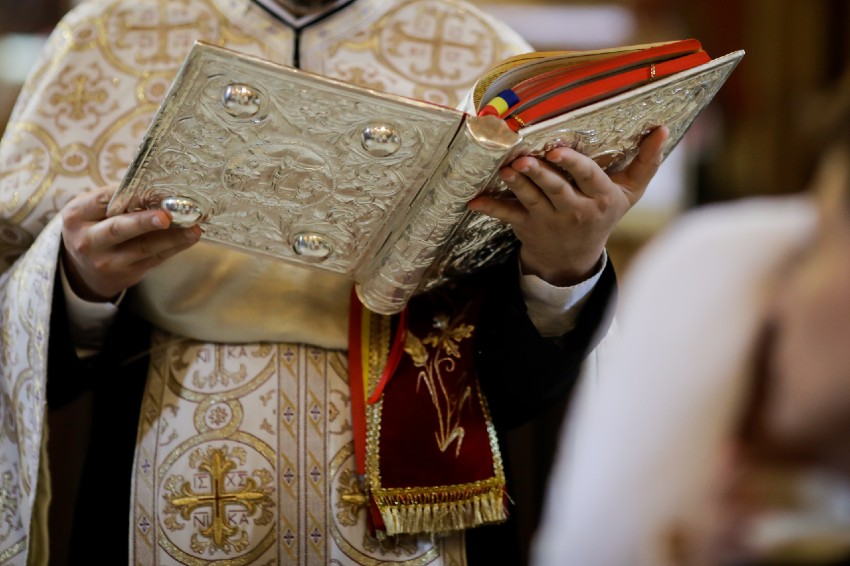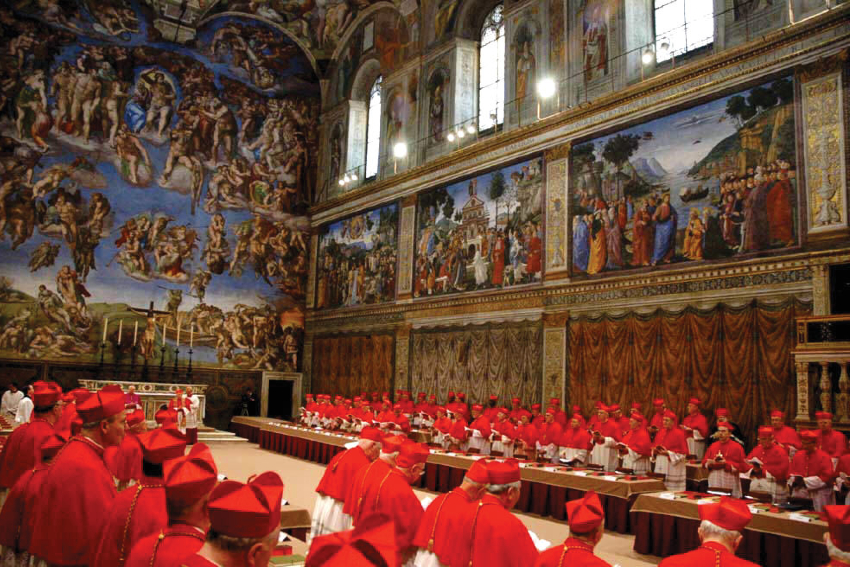Friday, April 26, 2019
I received a number of emails about my Letter #19 yesterday, entitled “Bannon’s Italian Monastery.”
The letters fall broadly into three main categories:
(1) people supportive of the initiative;
(2) people deeply skeptical about or opposed to the initiative;
(3) people who note the emergence of similar projects in other places as Christians attempt to restore the faith in an increasingly secularized, post-Christian Europe.
In Group (1):
One reader, a conservative American Catholic layman, wrote: “A very interesting detailing of the new Dignitatis Humanae Institute forming and getting underway. I had never heard of the Monastery, Organization, or Benjamin Harnwell. It certainly has ‘unglued’ and ‘enraged’ a host of liberals… They definitely are not happy with a new conservative entity that will challenge their liberal agenda… No doubt, Steve Bannon is a ‘lightning rod.’ With Cardinal (Raymond) Burke centering the Institute’s Board of Advisors, I have to believe solid conservative issues will be advanced. The Institute can be assured that every liberal entity will attack them with every resource available.”
Another, a Catholic priest and theologian, wrote: “I’m disappointed that all the articles reproduced here are violently against Bannon and Harnwell. Can’t you find at least one or two more positive articles to give Inside the Vatican readers a bit of balance? A lot of us out here think this initiative led by Bannon, Burke and Harnwell is absolutely fantastic — a ray of real hope for the future of the West and what remains of Christendom! The fact that the secular globalist left is evidently deeply alarmed by it is the best news of the week! Happy Eastertide!”
In Group (2):
An old friend wrote: “Julio Severo has a great deal to say about Bannon. Are you aware? What do you think? A lot to do with (Jair) Bolsonaro and, seemingly, the occult.”
Severo, a Brazilian pro-life blogger and activist, “a devout and observant charismatic evangelical,” is married with seven children (link). He is one of the founders of Brazil’s National Pro-Life and Pro-Family Network, and well-known in social conservative circles. He is the author of the book Prophetic Prayers, published by WestBow Press, a division of Thomas Nelson & Zondervan.
Severo contends that people in the circle of the new conservative Brazilian president, Jair Bolsonaro, including Olavo de Carvalho and Josias Teófilo, are influenced by “the traditionalism of the Islamic occultist René Guénon.” And he contends that Steve Bannon has also been influenced by Guénon (link).
Severo writes (link):
In Devil’s Bargain: Steve Bannon, Donald Trump, and the Storming of the Presidency (Penguin Publishing Group, 2017), author Joshua Green, who personally interviewed Bannon and Trump… explained that when Bannon was a young man, he was “a voracious autodidact” and he “embarked upon what he described as ‘a systematic study of the world’s religions,’” adding, “Taking up the Roman Catholic history… he moved on to Christian mysticism and from there to Eastern metaphysics… Bannon’s reading eventually led him to the work of René Guénon, an early-twentieth-century French occultist and metaphysician who was raised a Roman Catholic, practiced Freemasonry, and later became a Sufi Muslim”…
Green explained that “Guénon developed a philosophy often referred to as ‘Traditionalism’ (capital ‘T’), a form of antimodernism with precise connotations. Guénon was a ‘primordial’ Traditionalist, a believer in the idea that certain ancient religions, including the Hindu Vedanta, Sufism, and medieval Catholicism, were repositories of common spiritual truths, revealed in the earliest age of the world, that were being wiped out by the rise of secular modernity in the West.”
In Group (3):
Another old friend wrote:
Interesting stuff, Bob. Sounds a lot like what Marion Maréchal and Julien Lagella are doing with their Academia Christiana in France… (link) I’m reding Lagella’s book right now (slowly). He speaks of “re-evangelizing” France. Here he is in a video on YouTube (link).
I don’t know if you already know all this, but two other very similar initiatives are the populist political magazine L’Incorrect and the Catholic “radical ecology” movement Limite, discussed in a recent Rod Dreherpiece commenting on a Mark Lilla essay (link). There is more here and here. The latter two are light years beyond anything in English. For one thing, they have a sense of humor: (link).
Anyway, didn’t know if you followed the hip new French traditionalist scene but there it is. There are many possible synergies here.
He included a link to an interesting December 1, 2018 article in the American Conservative by Rod Dreher (link), containing ample citations from a Mark Lilla New York Review of Books article.
“Something new is happening on the European right, and it involves more than xenophobic populist outbursts,” Lilla writes.
“Ideas are being developed, and transnational networks for disseminating them are being established. Journalists have treated as a mere vanity project Steve Bannon’s efforts to bring European populist parties and thinkers together under the umbrella of what he calls The Movement.
“But his instincts, as in American politics, are in tune with the times… In countries as diverse as France, Poland, Hungary, Austria, Germany, and Italy, efforts are underway to develop a coherent ideology that would mobilize Europeans angry about immigration, economic dislocation, the European Union, and social liberalization, and then use that ideology to govern.”
JOIN DR. ROBERT MOYNIHAN FOR AN EXTRAORDINARY PILGRIMAGE IN IRELAND IN AUGUST…
=========
Three reflections
So what is one to make of all this?
These are merely preliminary reflections. (Apologies for their inadequacies.)
They are made in light of the fact that Emeritus Pope Benedict has told us that the Church will become much smaller. (link)
Benedict wrote in 1969(!), when he was a 42-year-old theologian in Germany:
“From the crisis of today the Church of tomorrow will emerge—a Church that has lost much. She will become small and will have to start afresh more or less from the beginning. She will no longer be able to inhabit many of the edifices she built in prosperity…
“The Church will be a more spiritualized Church, not presuming upon a political mantle, flirting as little with the Left as with the Right…
“But when the trial of this sifting is past, a great power will flow from a more spiritualized and simplified Church. Men in a totally planned world will find themselves unspeakably lonely. If they have completely lost sight of God, they will feel the whole horror of their poverty. Then they will discover the little flock of believers as something wholly new. They will discover it as a hope that is meant for them, an answer for which they have always been searching in secret.
“And so it seems certain to me that the Church is facing very hard times. The real crisis has scarcely begun. We will have to count on terrific upheavals. But I am equally certain about what will remain at the end: not the Church of the political cult, which is dead already, but the Church of faith. She may well no longer be the dominant social power to the extent that she was until recently; but she will enjoy a fresh blossoming and be seen as man’s home, where he will find life and hope beyond death.”
These reflections are also made in light of what the tireless American writer Rod Dreher (who has converted to Orthodoxy), has encouraged: that Christians embrace what he calls “The Benedict Option“ and enter into small Christian communities to avoid falling away from the faith as the trend in modern society increasingly turns anti-Christian (for it does seem that the time that is upon us is the time of all that is “anti-Christ.”)
(1) My first reflection stems from an extraordinary conversation I had with Dr. Joaquin Navarro-Valls, then the Vatican press spokesman, in 2001.
Dr. Daniel Schmidt, then Vice-President of the Bradley Foundation of Milwaukee, Wisconsin, and I had just been in Russia, and had traveled down to Rome to meet with Dr. Navarro-Valls to discuss Pope John Paul II‘s vision for a possible “rapprochement” with “the East” in an effort to help the Church in Europe, and the world, “breathe with two lungs.”
Navarro-Valls was adamant about one point: that the Pope hoped to raise up, using whatever means possible, all those who had in some way been “beaten down” under totalitarianism, under the police states of the East.
“It is an anthropological question,” Navarro-Valls said. “The center of John Paul’s concern is man and man’s dignity, which in its full form is his salvation. It is the anthropological question. What is man? What is man’s true nature? How can that true nature be discovered, healed, made whole, saved? The struggle is to protect the true dignity of men and women, to know what that true dignity is, to protect and defend that dignity.”
Some of these remarks echoed words in the interview I published two days ago with Archbishop Claudio Gugerotti, the Pope’s nuncio in Ukraine.
The archbishop, who has brought much aid to the many thousands of displaced people in eastern Ukraine, spoke of his desire to see the people who lived under Communism, who had in some way suffered a diminishment of their personal freedom, their personal identity, in the process of collectivization.
Gugerotti said this: “Perhaps the communist world had the illusion of thinking that the mass of men could help individuals to stand up, but an anonymous entity cannot become a personal entity. And we don’t need masses rising up. We need people who stand up, one by one, each with his own pace and each with his own position. And the second thought that comes to me, connected to this, is that when the person stands up, he already has the strength to look into the eyes of the person in front of him. This is why the second aspect of dignity, which is victory over fear, is very important for Ukraine.”
So my first reflection is that our problem, as ever, is man, the nature of man, the true meaning of man’s existence, an anthropological question — asked with ever greater insistence as we create powerful computers in an effort to produce “artificial intelligence” (AI) and propose the genetic modifications of men and women.
(2) This second reflection is that, in our age, in our globalized and “technologically advanced” world we have forgotten the truth about man, and so we have no possibility of offering true healing, true dignity, true salvation, to men and women.
We are so confused about the meaning of our lives that we think we may live without any transcendent dimension or orientation, and without any moral dimension, and without any relationship with the eternal.
But…
(3) We cannot live truly without an eternal dimension, for it is an axiom that man is made in the image and likeness of God, as a person, as a being with a transcendental horizon — never fully at home in space and time, ever a pilgrim, a wanderer, a castaway, waiting to return to our true home.
This is our true condition. And we can only set out on our journey by realizing that this is our condition.
(4) As a consequence, knowledge of how this world, this universe, works —advances in technology, breakthroughs in science (we might sum it up in the word “scientific progress” toward a desired “complete knowledge” and therefore “total power”) — cannot supply what man needs in his existential predicament. No matter how much science (the word means “knowing”) advances, man’s dignity, his healing, comes not from any knowledge (gnosis) but from a transcendence of knowing.
Not from knowing, and gnosticism, but from faith.
(5) The transmission of faith, which is the source of spiritual life, is a mysterious process. It may and does come through a personal encounter, a gaze, the gaze from one person’s eyes to another person’s eyes. Because hidden behind our physical eyes is something spiritual — our personhood.
The gaze itself conveys a type of spiritual “bread.”
This faith is not conveyed by knowledge. It is especially not conveyed by a special secret knowledge in the custody of initiates.
It is conveyed by respect, gratitude, forgiveness, all of those things that a person can give and receive, but a computer cannot give or receive, a mass movement cannot give or receive, an ideology cannot give or receive.
(6) The sacramental system of the Church is, yes, a series of initiations, but they are mysteries (sacraments; the Greek word for “mystery” is translated into Latin as the word “sacrament” — the two words refer to the same thing.)
Not secrets. Sacraments. Nothing is hidden, though some things are done quietly and without fanfare.
And these sacraments bring the souls of men and women into contact with Him, the source of our being and the end of all of our striving, our true homeland.
(7) So the first, preliminary conclusion is this: the effort to build centers of study and political analysis in places like the monastery of Trisulti in Italy, and in other places in Europe, may be important in the effort to combat the secularization and the anti-Christian policies of the increasingly powerful elites of our age. But, this effort must not slip into a type of gnosticism, or a time of elitism, detached from the deep spiritual roots which truly nourish human dignity and spring forth in marvelous works of political and social justice, of charity, and of science and intellect.
The only way these efforts may be truly fruitful is if they are rooted in the perennial faith and sacraments of the Church.
If they are so rooted, if they are not purely political, purely partisan, these efforts will strengthen the Church, and the western culture and world culture the Church fosters, so that, as Ratzinger said, “the Church will enjoy a fresh blossoming” and “be seen as man’s home, where he will find life and hope beyond death.”
The monastery of Trisulti in Collepardo, near Frosinone, in central Italy south of Rome. It was consecrated in 1211, more than 800 years ago. It has been entrusted to the Dignitatis Humanae Institute and Steve Bannon to become a training center for European Conservatives.
The history of the monastery
Trisulti Charterhouse (Italian: Certosa di Trisulti) is a former Carthusian monastery or charterhouse, in Collepardo, province of Frosinone, central Italy. It was consecrated in 1211, becoming a national monument in 1873.
In 1947, the monastery was taken over by the Cistercian Congregation of Casamari Abbey and continues as a Cistercian monastery. However, in recent years only two elderly monks have been living at the monastery.
The former White House Chief Strategist, Steve Bannon, announced in 2018 plans to establish an academy in the charterhouse.
Join Dr. Moynihan in his work. Click here now to Sponsor The Moynihan Letters










Facebook Comments